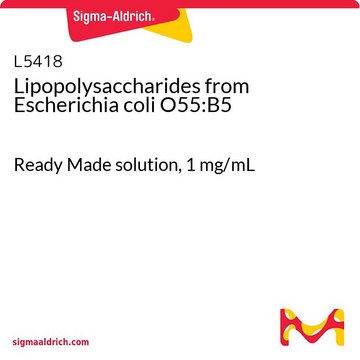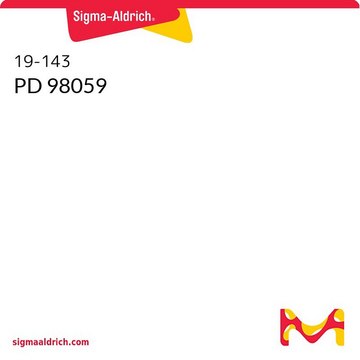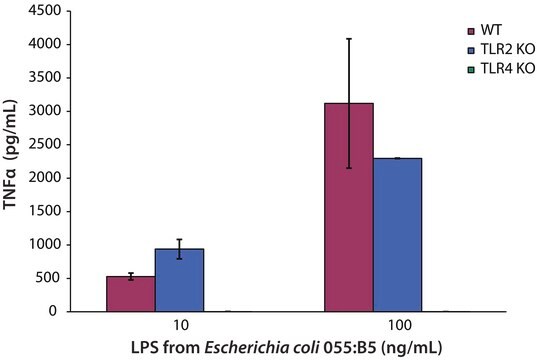L5543
Lipopolysaccharides from Escherichia coli O26:B6
Ready Made solution, 1 mg/mL, 0.2 μm filtered
Synonym(s):
LPS
Sign Into View Organizational & Contract Pricing
All Photos(1)
About This Item
Recommended Products
biological source
Escherichia coli (O26:B6)
Quality Level
sterility
0.2 μm filtered
form
aqueous solution
concentration
1 mg/mL
color
colorless to faint yellow
solubility
water: soluble
shipped in
wet ice
storage temp.
2-8°C
Looking for similar products? Visit Product Comparison Guide
General description
This product is a 0.2 um filtered aqueous solution containing 1 mg/mL of lipopolysaccharides (LPS) from E. coli serotype O26:B6. This LPS serotype has been used in studies of septic shock.
Application
Lipopolysaccharides (LPSs) are characteristic components of the cell wall of Gram-negative bacteria. LPS and its lipid A moiety stimulate cells of the innate immune system by the Toll-like receptor 4 (TLR4), a member of the Toll-like receptor protein family, which recognizes common pathogen-associated molecular-patterns (PAMPs).
Biochem/physiol Actions
Lipopolysaccharides (LPS) are localized in the outer layer of the membrane and are, in noncapsulated strains, exposed on the cell surface. They contribute to the integrity of the outer membrane, and protect the cell against the action of bile salts and lipophilic antibiotics.
Preparation Note
The LPS used to prepare the solution have been phenol-extracted and chromatographically purified by gel filtration. Lipopolysaccharides prepared by phenol extraction contain up to 60% RNA and less than 1% protein. Subsequent purification by gel filtration chromatography removes much of protein present in the phenol-extracted LPS, but leaves a product that still contains 10-20% nucleic acids. Further purification using ion exchange chromatography yields an LPS product which contains <1% protein and <1% RNA.
Other Notes
To gain a comprehensive understanding of our extensive range of Lipopolysaccharides for your research, we encourage you to visit our Carbohydrates Category page.
related product
Product No.
Description
Pricing
Storage Class Code
12 - Non Combustible Liquids
WGK
WGK 1
Flash Point(F)
Not applicable
Flash Point(C)
Not applicable
Personal Protective Equipment
dust mask type N95 (US), Eyeshields, Gloves
Choose from one of the most recent versions:
Already Own This Product?
Find documentation for the products that you have recently purchased in the Document Library.
Customers Also Viewed
Seema Yousuf et al.
Molecular neurobiology, 58(3), 950-963 (2020-10-17)
Vitamin D deficiency (Ddef) alters morphology and outcomes after a stroke. We investigated the interaction of Ddef following post-stroke systemic inflammation and evaluated whether administration of progesterone (P) or vitamin D (D) will improve outcomes. Ddef rats underwent stroke with
Helena Cucak et al.
PloS one, 9(3), e90685-e90685 (2014-03-07)
Type 2 diabetes (T2D) is evolving into a global disease and patients have a systemic low-grade inflammation, yet the role of this inflammation is still not established. One plausible mechanism is enhanced expression and activity of the innate immune system.
Johanna Matilainen et al.
Lipids in health and disease, 19(1), 70-70 (2020-04-15)
Orotic acid (OA) has been intensively utilized to induce fatty liver in rats. Although the capacity of OA to cause steatosis is species-specific, previous in vitro studies indicate that humans could also be susceptible to OA-induced fatty liver. The aim
Mi Joung Kim et al.
Nutrition research and practice, 5(5), 404-411 (2011-11-30)
This study investigated the effects of freeze-dried cranberry powder on anti-inflammation and lipid profiles of lipopolysaccharide (LPS)-treated rats fed an atherogenic diet for 6 weeks. Forty Sprague-Dawley male rats (6-weeks-old) were equally divided into the following five groups: 1) normal
Maurizio Ceppi et al.
Proceedings of the National Academy of Sciences of the United States of America, 106(8), 2735-2740 (2009-02-06)
In response to inflammatory stimulation, dendritic cells (DCs) have a remarkable pattern of differentiation (maturation) that exhibits specific mechanisms to control immunity. Here, we show that in response to Lipopolysaccharides (LPS), several microRNAs (miRNAs) are regulated in human monocyte-derived dendritic
Our team of scientists has experience in all areas of research including Life Science, Material Science, Chemical Synthesis, Chromatography, Analytical and many others.
Contact Technical Service





